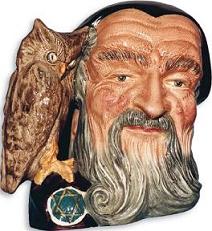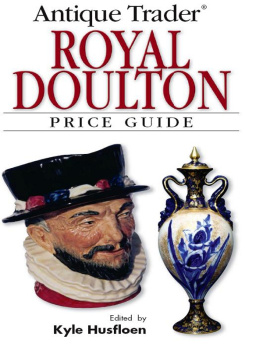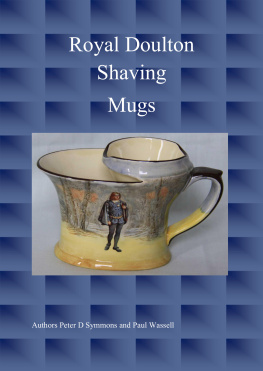 Antique Trader
Antique Trader
ROYAL
DOULTON
PRICE GUIDE

Edited by
Kyle Husfloen 2006 by Krause Publications Published by
 700 East State Street Iola, WI 54990-0001715-445-2214888-457-2873
700 East State Street Iola, WI 54990-0001715-445-2214888-457-2873 Our toll-free number to place an order or obtain
a free catalog is (800) 258-0929. All rights reserved. No portion of this publication may be reproduced or transmitted in any form or by any means, electronic or mechanical, including photocopy, recording, or any information storage and retrieval system, without permission in writing from the publisher, except by a reviewer who may quote brief passages in a critical article or review to be printed in a magazine or newspaper, or electronically transmitted on radio, television, or the Internet. Library of Congress Catalog Number: 2006930828 ISBN 13-digit: 978-0-89689-320-7
ISBN 10-digit: 0-89689-320-0
eISBN: 978-1-44022-510-9 Designed by Wendy Wendt
Edited by Kyle Husfloen Printed in the United States of America TABLE OF CONTENTS INTRODUCTION
DOULTON - Charming Characters, Lovely Ladies and Much, Much More For the vast majority of the American collecting community the Royal Doulton Company is synonymous with Character Jugs and Figurines. Although these have long been the best known lines manufactured by this leading English pottery there is a great deal more to the Doulton story than just these two categories. I hope our new
Antique Trader Royal Doulton Price Guide will help enlighten our collecting community to the wide range of wonderful ceramics that were produced by Royal Doulton and its ancestor, Doulton & Company.
For those of you who are readers of the Antique Trader Antiques & Collectibles Price Guide you may be aware that in our Ceramics section we always run a listing of Doulton & Royal Doulton wares. We use the combined title because it best reflects all the wares we include in this general price guide. Now this new book will provide a much more comprehensive guide to all the wares produced at Doulton factories for well over 100 years. Back before the middle of the 19th century there were already members of the Doulton clan manufacturing pottery, but it was very industrial-type wares such as sewer piping. It wasnt until the 1860s that a younger generation of Doulton family decided to change direction and begin producing high quality earthenware and stoneware pottery decorative wares. This was the era when Europe and America were launching the Art Pottery movement and Doulton & Company joined this movement with great vigor.
During the last quarter of the 19th century their two major potteries, one in the town of Lambeth and the other in the nearby town of Burslem, manufactured a wide range of artistic wares, very often designed and executed by leading ceramics artists. It wasnt until 1902 that the company named was changed to Royal Doulton but they continued their wide-ranging production of artistic wares for every taste. Collectors should keep in mind that the firms well-known series of Character Jugs and Figurines were not actually introduced until well into the 20th century. You will learn much more about all of this by reading this guide, a work that wouldnt have been possible without the invaluable assistance of, Louise Irvine. Louise is one of the best-known authorities in the field of Doulton wares, having written numerous reference books, including the revised Doulton Lambeth Wares. As one Doulton collector told me, Louise has forgotten more about Doulton than most of us will ever know.
This delightful and enthusiastic British lady has been a driving force behind the production of this guide and I extend to her my heartfelt thanks. Also, I must also give special thanks to Reg Morris, who has supplied me with Doulton price listings and color images for several years. His special interest has been in the collectible Bunnykins series and he also provided a great deal of material on Royal Doulton Character Jugs and Figurines. It has taken over a year of hard work and dedication to produce the volume you now have in front of you. Im sure you will agree that it was time well spent and I sincerely believe you will soon find the Antique Trader Royal Doulton Price Guide an invaluable part of the antiques reference library. Good luck and happy hunting.
Kyle Husfloen, Editor Please note: Though listings have been double-checked and every effort has been made to insure accuracy, neither the compilers, editors nor publisher can assume responsibility for any losses that might be incurred as a result of consulting this guide, or of errors, typographical or otherwise.
ON THE COVER: Left Large Beefeater Character Jug, $125; Right Billie and Buntie Bunnykins Sleigh Ride figure, $45. Photos courtesy of Reg Morris. A Guide to Doulton & Company and Royal Doulton Collecting By Louise Irvine The Doulton company dates back to 1815 when John Doulton invested his savings in a small pottery in south London run by a widow, Martha Jones and her foreman, John Watts. The potterys main business was making bottles, jars, mugs, barrels and other containers for domestic use and the spirit trade. The material used was salt-glazed stoneware, a high-fired ceramic body, brown or buff in colour, which was glazed with salt. (See Chapter 8)  An early Doulton stoneware bottle.
An early Doulton stoneware bottle.  Doulton Hunting Ware tyg (three-handled mug) with hound-shaped handles, ca. 1880 John Doulton was a skilled potter and spent his days throwing pots on his wheel and his evenings selling them. 1880 John Doulton was a skilled potter and spent his days throwing pots on his wheel and his evenings selling them.
Doulton Hunting Ware tyg (three-handled mug) with hound-shaped handles, ca. 1880 John Doulton was a skilled potter and spent his days throwing pots on his wheel and his evenings selling them. 1880 John Doulton was a skilled potter and spent his days throwing pots on his wheel and his evenings selling them.
When Mrs Jones retired, Doulton and Watts carried on the business and moved to High Street, Lambeth in 1826. From this date, they began using the trademark Doulton & Watts which can be found impressed on their wares. This mark continued to be used even after John Watts retirement in 1853 when the firm became known as Doulton & Co. Henry Doulton John Doultons son, Henry, joined the business in 1835, at the age of 15, and began learning all the pottery processes. He soon became the entrepreneur of the industry, discovering many different uses for the potterys products. Initially he concentrated his energies on developing ceramics for the building trade and chemical industries and he was a pioneer in sanitary wares, establishing the first drainpipe factory in the world in 1846.
Collectors can find miniature pipes that were used as salesmens samples throughout the 19th and early 20th centuries.  Collection of miniature Doulton stoneware drain pipes and junctions. Tinworth the First Doulton Artist In the 1860s, Henry Doulton began experimenting with decorative ceramics, initially making copies of Rhenish stonewares from Germany which became collectible in the 1860s. He was encouraged by the principal of the new Lambeth Art School who offered his students as decorators. One of the most talented, George Tinworth, was offered a job at the Doulton pottery in 1866 and began to decorate stoneware jugs and vases with beaded runners and raised bosses, a style he favoured throughout his career at the Lambeth pottery. However, Tinworth became better known for his sculptural work, mainly terra cotta panels inspired by the Bible, which were commissioned for churches and chapels.
Collection of miniature Doulton stoneware drain pipes and junctions. Tinworth the First Doulton Artist In the 1860s, Henry Doulton began experimenting with decorative ceramics, initially making copies of Rhenish stonewares from Germany which became collectible in the 1860s. He was encouraged by the principal of the new Lambeth Art School who offered his students as decorators. One of the most talented, George Tinworth, was offered a job at the Doulton pottery in 1866 and began to decorate stoneware jugs and vases with beaded runners and raised bosses, a style he favoured throughout his career at the Lambeth pottery. However, Tinworth became better known for his sculptural work, mainly terra cotta panels inspired by the Bible, which were commissioned for churches and chapels.
Next page










 Antique Trader
Antique Trader Edited by
Edited by 700 East State Street Iola, WI 54990-0001
700 East State Street Iola, WI 54990-0001 An early Doulton stoneware bottle.
An early Doulton stoneware bottle.  Doulton Hunting Ware tyg (three-handled mug) with hound-shaped handles, ca. 1880 John Doulton was a skilled potter and spent his days throwing pots on his wheel and his evenings selling them. 1880 John Doulton was a skilled potter and spent his days throwing pots on his wheel and his evenings selling them.
Doulton Hunting Ware tyg (three-handled mug) with hound-shaped handles, ca. 1880 John Doulton was a skilled potter and spent his days throwing pots on his wheel and his evenings selling them. 1880 John Doulton was a skilled potter and spent his days throwing pots on his wheel and his evenings selling them. Collection of miniature Doulton stoneware drain pipes and junctions. Tinworth the First Doulton Artist In the 1860s, Henry Doulton began experimenting with decorative ceramics, initially making copies of Rhenish stonewares from Germany which became collectible in the 1860s. He was encouraged by the principal of the new Lambeth Art School who offered his students as decorators. One of the most talented, George Tinworth, was offered a job at the Doulton pottery in 1866 and began to decorate stoneware jugs and vases with beaded runners and raised bosses, a style he favoured throughout his career at the Lambeth pottery. However, Tinworth became better known for his sculptural work, mainly terra cotta panels inspired by the Bible, which were commissioned for churches and chapels.
Collection of miniature Doulton stoneware drain pipes and junctions. Tinworth the First Doulton Artist In the 1860s, Henry Doulton began experimenting with decorative ceramics, initially making copies of Rhenish stonewares from Germany which became collectible in the 1860s. He was encouraged by the principal of the new Lambeth Art School who offered his students as decorators. One of the most talented, George Tinworth, was offered a job at the Doulton pottery in 1866 and began to decorate stoneware jugs and vases with beaded runners and raised bosses, a style he favoured throughout his career at the Lambeth pottery. However, Tinworth became better known for his sculptural work, mainly terra cotta panels inspired by the Bible, which were commissioned for churches and chapels.